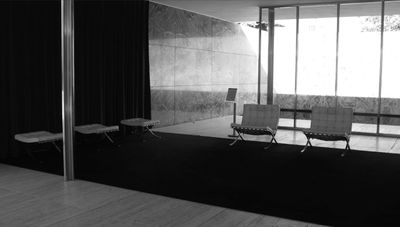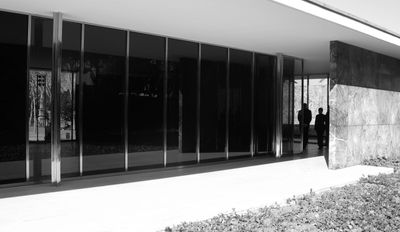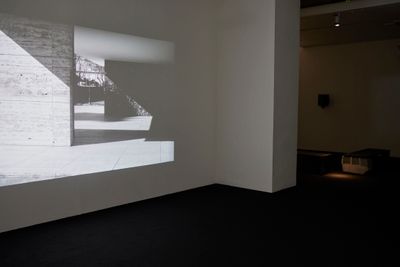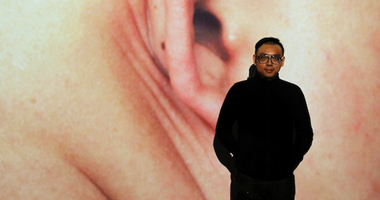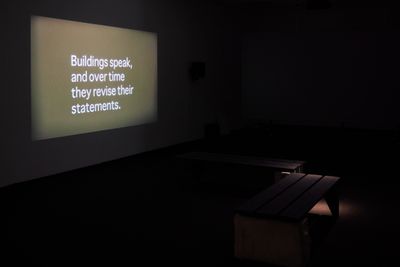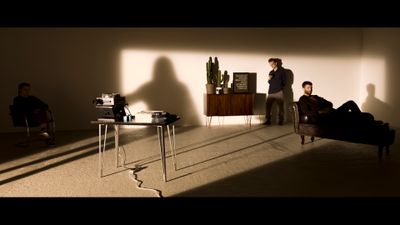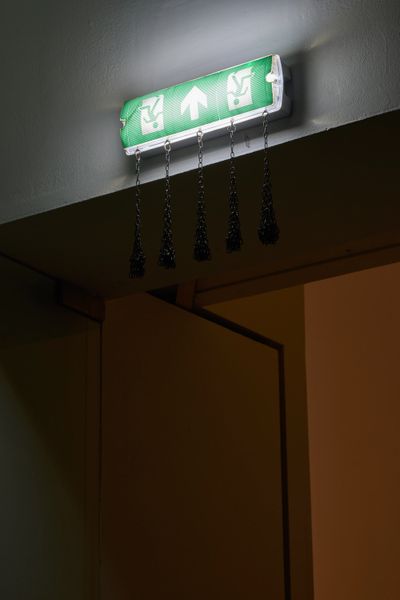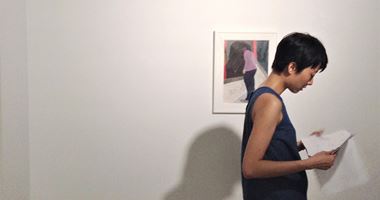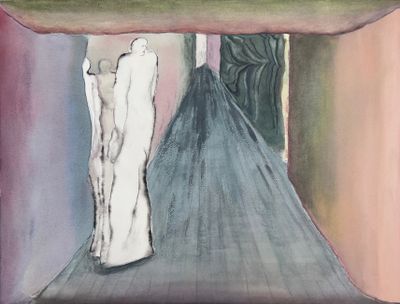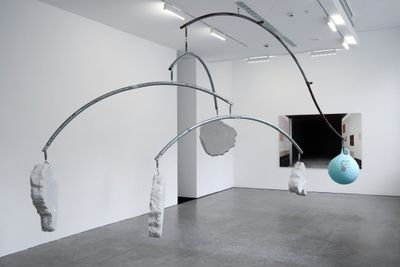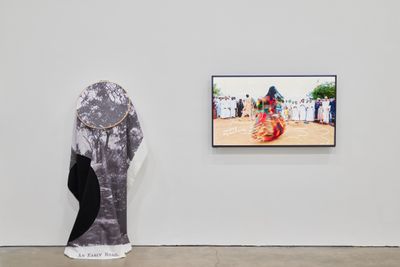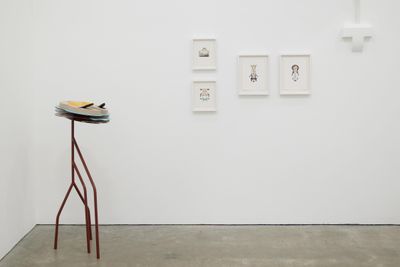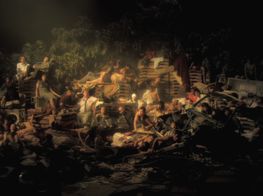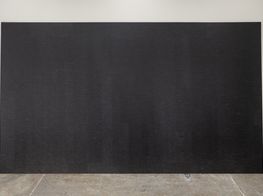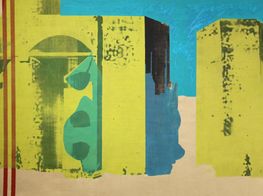At Ikon Gallery, Modernist Horror Gives Way to Speculative Form

Ho Tzu Nyen, The Cloud of Unknowing (2011) (still). HD projection, 13-channel sound, smoke machines, floodlights, and show control system. Courtesy the artist and Kiang Malingue Gallery, Hong Kong.
Birmingham was hit hard during World War II, becoming the third most bombed city in the United Kingdom behind London and Liverpool. Today, the city's wartime scars don't exist as ruins or catastrophic imprints on the urban landscape, but as brutalist buildings that arose like concrete keloids to replace what was lost.
From this context, Horror in the Modernist Block unfolds at Birmingham's Ikon Gallery (25 November 2022–1 May 2023), with a group show featuring works by 20 international contemporary artists, including Shezad Dawood and Monika Sosnowska, deftly curated by Ikon curator Melanie Pocock.
Organised around the theme of architectural brutalism and its horrors, the show opens in Ikon's darkened, first-floor gallery, where a theatrical choreography of sequenced videos starts with Maria Taniguchi's looped single-channel video, Mies 421 (2010).
A lone, metronomic beat, evocative of a Kotsuzumi drum, heightens the dramatic suspense that punctuates a slideshow of black-and-white images. They show pictures of Ludwig Mies van der Rohe and Lilly Reich's Barcelona Pavilion, designed to house Germany's national pavilion at the 1929 Barcelona International Exposition.
Focusing on the structure's minimalist, hard-edge lines, executed with steel, glass, and marble, Taniguchi's camera explores a foundational reference point in modernist architecture with unnerving objectivity. Such that a bronze cast of Georg Kolbe's Dawn (1929), of a woman shading her eyes from a rising sun, appears like a spectre frozen in a protective stance in the face of a cataclysm; here, entombed by a building whose sole purpose is to frame empty—or emptied—space.
The following videos expand on the premise of exhibition-as-horror movie. There's NT's Ikon commission BRUTAL (2022), whose foreboding soundtrack amplifies the voyeuristic angles that capture Birmingham's housing estates at night, turning every viewer into a stalker.
Offering a contextual expansion to the frame is Ho Tzu Nyen's The Cloud of Unknowing (2011), which made use of a public housing block in Singapore—managed by the government-run Housing and Development Board, whose projects house around 80 percent of Singapore's population—ahead of its demolition.
Eight characters living within compartmentalised spaces, including a death metal drummer and a man surrounded by books, exist in their unique worlds. Feelings of isolation and imaginative liberation oscillate until the work's climax; everyone becomes enveloped by a cloud that eventually puffs out into the gallery through the activation of a smoke machine.
Ho has talked about how development in Singapore has effectively smoothed out the complexities of the nation-state's tumultuous past—gaining independence from British rule before breaking away from Malaysia in 1965 to become a sovereign state defined by a multilingual, multicultural population.
That smoothing speaks to the modernist project in the post-war era, with emphasis on minimalism and seriality that has manifested across scales. From utilitarian high-rise blocks that define cities and lives around the world, to the nation-state, whose structural variations never stray too far from the concept's core, pyramidal form.
Offering an overarching view of this global structuralism is Karin Kihlberg and Reuben Henry's video lecture Slow Violence (2018–2022), a manifesto delivered by three performers in the version of the work shown here, on the violence of urbanisation filmed inside a dark London flat.
Slow Violence is illustrated with slides of construction sites and promotional renderings of upcoming developments. A consistent hammering in the video creates an acoustic link to Taniguchi's study of modernist architecture, with grid-like structures of division that create hierarchies of access in the process.
Describing architecture as 'house arrest', one question in Slow Violence resonates in a post-pandemic lockdown era defined by a cost-of-living crisis: 'Can you afford to choose the terms of your internment?' The horror of modernist architecture, then, which in Britain has been associated with the abject failure of 20th-century public housing blocks, and in Singapore has led to a booming 21st-century housing market, is thus updated for the present.
Today, real estate values—and indeed, management—can define a person's right to live, as demonstrated in the ritual mourning chains that artist Abbas Zahedi attached to an upside-down exit sign glowing over the gallery entrance. As Zahedi notes, Exit Sign (2021) mourns the victims of the Grenfell Tower inferno, fuelled by cladding intended to beautify a public housing block set in one of London's richest boroughs, who were instructed not to exit the building.
Zahedi highlights the fact that exiting a building, and the socio-political system that building represents, is a privilege, in a text included in the Artists' Image Archive, a printed board with images and notes by exhibiting artists on architectures that have inspired their practice.
Next to Zahedi's note is a paragraph by Firenze Lai, whose distinctive figurative paintings on the second floor depict ghostly figures encased by their equally ghostly surroundings. Lai presents a photograph of a man she captured sleeping under a busy flyover in central Hong Kong, on a cobbled pavement whose terracing is meant to deter homeless people from sleeping there. 'The man just doesn't care; he's totally at ease,' Lai writes, effectively highlighting an act of disobedience against the violence of urban design.
Karim Kal, whose large-format photographs in the show turn underpasses in Lyonnaise housing estates into gaping black voids, anchors that violence in his own note. He describes modernist icon Le Corbusier's plan for Algiers, which would have cut the city into two halves and denied one side its view of the sea.
Kal's unnerving anecdote ominously shrouds Seher Shah's three etchings hung nearby, with geometric compositions referencing Le Corbusier's distinctive Housing Unit grids, which shaped the basic design for public housing blocks in the post-war era.
Hanging in the centre of the room, Richard Hughes' Calder-esque mobile Lithobolia Happy Meal (2022) gives form to Le Corbusier's spectre. Polyester resin and fibreglass lumps imitating concrete rubble hang alongside a blue wrecking ball with a smiley face crudely drawn on it, linking a 17th-century folk tale about a stone-throwing devil with the spirit of demolition that underpins modernist urbanisation.
But while Horror in the Modernist Block amplifies the many hauntings of a design philosophy that continues to shape the present, the show's second floor resists dead-end conclusions by opening pathways for speculation.
Perfectly framed by an interior wooden arch that speaks to Ikon's Grade II-listed neo-gothic building is Ismael Monticelli's commission Spaghetti Junction (2022). A giant blue triangle painted on a wall hosts paintings and golden papier-mâché hieroglyphs that entangle references to Oscar Niemeyer's Brasília, Birmingham's skyline, and ancient Egyptian and Aztec aesthetics, to comment on modern cities as sites of ritual sacrifice.
But despite its allusions to violence, Spaghetti Junction offers an opening in its emphasis on the fact that hypothetical propositions manifest as actual structures on the basis of belief. Ola Hassanain's video, The Line That Follows (2022), similarly annotates archival footage of a community dancing in Khartoum, Sudan, with notes that describe space as something people do.
With that in mind, Amba Sayal-Bennett's sculptural compositions, developed from computer-aided design models, convert the exhibition's horror into science fiction. Installed in the top corner of a rectangular alcove is the parasitic Aperture (2020). A black powder-coated steel sheet is attached to the wall like a triangular prism's open template, with a clean slit down the centre.
Sayal-Bennett creates these uncanny compositions with a CNC machine, where computers cut shapes from pre-programmed designs. While powder-coated steel is among the more common materials the artist utilises, the standing sculpture Carus (2020) layers steel, chemiwood, MDF, and resin of pastel blue, yellow, and black shades.
Resting on slim, metallic legs, Carus appears at once like the slice of a human torso cut at the base of the spine, and an alien cyborg awakening from its technical paralysis to take its first step. It's a futuristic, otherworldly form that seems to counter the idea that sculpture, like architecture, solely serves the slow violence of the modernist industrial complex—a point Kihlberg and Henry confront in the first gallery.
Such oscillations between point and counterpoint characterise this incisive and necessarily open-ended exhibition, which is structured by the catch-22 of its subject. The technological tools of humanity's creation and destruction are as speculative as they are constrictive, after all. —[O]

